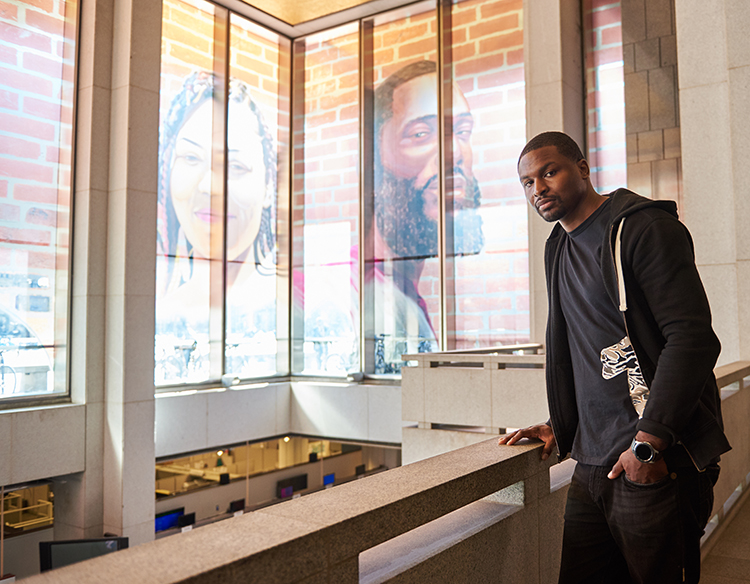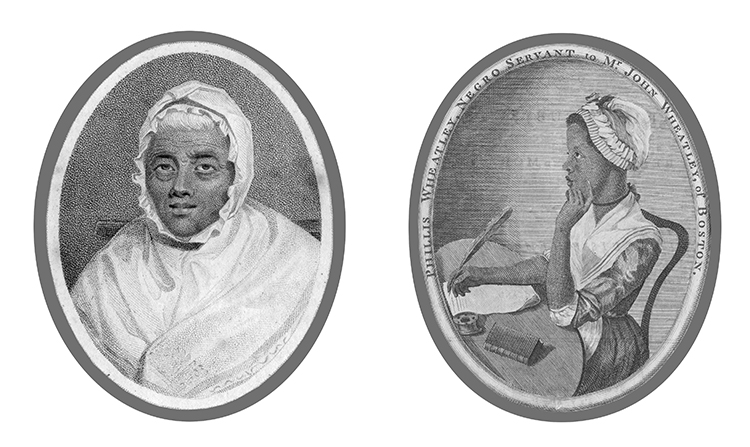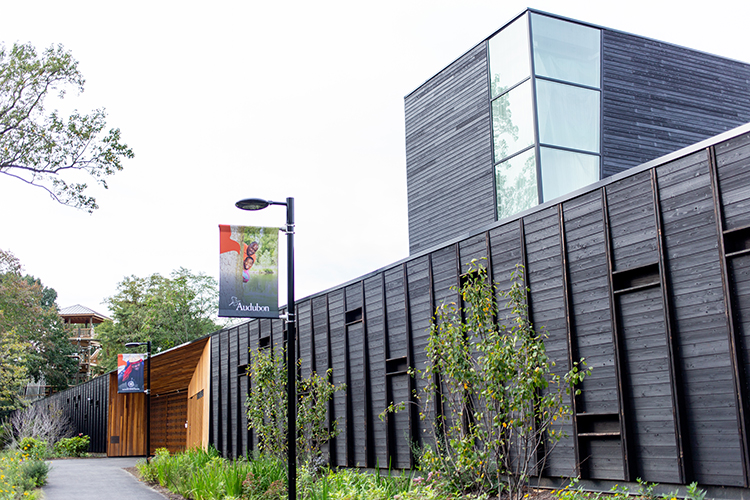Photo: Natalie Pisercho
Mass incarceration is a daunting problem with racial implications. Public art and educational efforts aim to start a conversation.
By Alexandra Wagner Jones
Russell Craig stands in his Fairmount art studio, a few floors up in a brownstone church. It’s a little messy—there are buckets of paint stacked against the walls and acrylic paint tubes scattered between plastic tubs and paintbrushes on the floor—but he isn’t embarrassed by the chaos.
“This is the process,” he says.
Craig is a self-taught artist who was incarcerated for nearly 10 years on a nonviolent drug offense, for dealing cocaine.
After being released, Craig came to know another artist who had just finished time for cocaine-dealing charges, Jesse Krimes. The two met at the Restorative Justice Guild, an apprenticeship program that teaches former inmates hands-on skills like carpentry, landscaping, and mural and mosaic creation. Krimes, who holds a bachelors in Studio Art from Millersville, had just been released from prison after nearly six years.
After looking through a few large rolls of paper, Craig picks out one and spreads it flat on the floor. It’s a portrait he’s done of a smiling man in a green shirt. He has warm eyes, a tight-cropped haircut and a chin strap beard. It’s one of Craig’s art students. He and Krimes are now teachers with the Guild, helping its cohorts with art projects that support returning citizens.
By early October, Craig had painted 17 of his students’ portraits, and after having them photographed and blown up onto slabs of vinyl, all 17 faces were then wrapped around the base of the Municipal Services Building, just across from City Hall. They’ll remain there until December.
A large-scale outdoor exhibit, the project is called “Portraits of Justice,” and its central location is meant to encourage all Philadelphians to discuss problems within the criminal justice system. It serves as a backdrop for participatory public art, with past performances from formerly incarcerated artists with Mural Arts Philadelphia.
The massive portraits will eventually all but disappear. The mural was designed so that people can wipe the bricks away and write in potential fixes for the reentry system with paint markers. The wall’s erasure, Krimes says, will symbolize that the system can be dismantled.
From what he has gathered from reactions to his previous projects, Krimes says most people have no idea that incarceration rates are so high.
“People really don’t have a good understanding of what the criminal justice system entails,” he says. “Or how unjust it actually is.”
A Country of Prisoners
In November 2017, lifelong civil rights lawyer Larry Krasner rose to give his victory speech after being elected as the city’s district attorney by an overwhelming majority.
“We believe it’s time to end mass incarceration,” he shouted into a microphone to a cheering crowd. This was the crux of the campaign, a pledge to radically reform the city’s criminal justice system.
“Mass incarceration and other civil rights issues are arguably the biggest issues of our time, and they require a mass movement to change,” Krasner says, when speaking with Grid in a recent phone interview. “We’re the most incarcerated country in the world, and that is an outrage in the country claiming to be the land of freedom.”
Holding more than 2.3 million inmates in its prisons and jails, the United States has the largest prison population in the world. The U.S. makes up about 4.28 percent of the world population, but about 22 percent of the world prison population.
“I think it’s outrageous and an affront to all people who care about justice and healing society,” Krasner says.
Over-incarceration is an unfortunate pattern across the country, but Philadelphia holds the dubious distinction among the United States’ largest cities of having the highest per capita incarceration rate, a distinction many hope is on its way out.
This past February, Krasner sent a memo to his staff detailing policies designed to “end mass incarcerations and bring balance back to sentencing.”
As Krasner describes it, working on criminal justice reform is a lot like tuning a car.
“What I mean by that is, every time you improve one part of the system, you are improving other parts of the system,” he says. In the same way a car will pollute less, be quieter, and accelerate more quickly when it’s properly tuned, when the criminal justice system is adjusted, the benefits will be many.
“So it doesn’t take forever to get to trial. So people are not in jail when they shouldn’t be. So fines and costs are not excessive. So immigrants are not marginalized,” Krasner says. “The whole system works better.”
Using this line of thought, Krasner’s new policies instruct prosecutors to stop prosecuting marijuana possession, regardless of weight, end cash bail for low-level charges and requests judges to limit probation after incarceration to no more than 12 months maximum.
Although at least one police union responded to these reforms by labeling Krasner “anti-law enforcement,” the district attorney’s new policies are meant to address the fact that most of Philadelphia’s 5,200 inmates are in jail for nonviolent offenses.
The city’s prisoners are typically a majority mix of accused persons held pretrial, convicts serving less than two years and parole violators.
These are the kind of offenses, Krasner says, that didn’t usually land someone behind bars 40 years ago.
“Certain types of offenses were crimes, but they weren’t serious enough for the offender to go to jail,” Krasner says. “There were other ways to hold an offender accountable. Somehow we lost track of that, and we started locking up people for all kinds of nonviolent offenses who did not need to be there.”
According to Krasner’s calculations, each inmate costs the city between $42,000 and $60,000 a year. All together, that’s around $218 million.
Numbers on Display
When Sean Kelley took a program directing job with Eastern State Penitentiary in 1995, he knew almost nothing about the criminal justice system.
Twenty-three years later, as he weaves in and out of cell corridors, the now director of interpretation talks in-depth about every exhibit on the old prison grounds. He can rattle off stories about inmates who lived at Eastern State in the 1800s, describing how they were kept in complete isolation in cells for 23 hours a day.
For those who think of Eastern State as an historic site, it may be surprising that Kelley’s excitement becomes most palpable when he talks about a more recent exhibit he led the curation of, “Prisons Today.” The exhibit has little to do with Eastern State’s dark past. Instead, it focuses heavily on imprisonment policies and practices tha
t have emerged since the prison closed in 1970: the age of mass incarceration.
“We are the closest thing America has to a national prison museum,” Kelley claims proudly, pointing at the ground. “There is no other place where people are really talking about mass incarceration.”
When visitors walk into “Prisons Today,” they’re met with the booming recorded voices of public officials, from both ends of the political spectrum, promising that mass incarceration will lower violent crime rates.
“Let’s double the penalty for two-time felons and put three-time losers behind bars for life. It’s time to turn career criminals into career inmates,” a crackly voice rings out.
The problem, Kelley explains, is that the promise doesn’t ring true. Looking at data compiled by U. S. Department of Justice’s Bureau of Justice Statistics, it’s clear that violent crime rates have remained steady as the War on Crime, three strikes you’re out and minimum-sentencing policies have increased the number of prisoners by more than 700 percent since 1970.
Later, visitors are faced with a large wall of handwritten criminal confessions, some of which are from formerly incarcerated individuals while others are from visitors. Light-up buttons underneath the messages indicate which messages are which, a demonstration of how arbitrary punishment can be.
After that, a breakdown of which states still let ex-convicts vote and which ban them for life. (In Pennsylvania you can vote after you’re released from prison, even while on parole.)
Kelley, who came to the museum as “a white kid from the suburbs,” readily admits that he was against putting this exhibit up for a long time.
“Every time we tried to talk about what happened we couldn’t find the words—it felt awkward,” he says. They worried it would seem non-neutral, like they were driving some kind of a political agenda.
But after talking to visitors in 2012 and 2013, the museum began to shift its programming to ensure visitors left with some contemporary knowledge of what the prison system is like today.
“For our audience, it actually made more sense to start with statistics and say, ‘Just forget about individuals—just look at the pattern,’ ” Kelley says, referring to the museums “mostly white” visitors.
Since the exhibit opened in May 2016, just a handful of people have complained about its contents.
“The pattern is there are dramatically more people in prison,” he continues, “and the racial disparities are growing worse.”
Kelley thinks statistics offer a perspective that individual stories cannot. No one person’s story can describe a generational shift in values that led to mass incarceration, but the numbers can.
People to the Power
There are more than 70 million people in this country with criminal records. Courtney Bowles and her friend Mark Strandquist are two of them.
Both white, the pair say their racial and economic privileges allow them to do things many with criminal backgrounds struggle to do, like teach at a university and own a home.
Aware of their privilege, Bowels says, and frustrated by inequality, she and Strandquist co-direct the Reentry Think Tank, an initiative that works with citizens reentering society to shift negative perceptions surrounding incarceration. In 2015, the Think Tank began running three-month fellowship programs with a dozen or so formerly incarcerated individuals twice a year.
Strandquist compares Reentry Think Tank to the U.S. Congress of reentry organizations. The applicants are carefully nominated and selected by reentry organizations around the city. When the chosen representatives meet, they discuss ways to tear down the barriers society puts in place for reentering citizens.
Participants create movies, poems and artwork that present their personal stories about reentry and the effects incarceration has on returning citizens, and then assemble these pieces into mobile exhibits. Although many exhibitions are pop-ups, to date, they’ve set up permanent installations at the Mayor’s Office of Reintegration Services and the Institute for Community Justice.
The mobile exhibit has also been displayed in the Philadelphia Museum of Art, but museums aren’t the only place the Think Tank displays its work.
Because museums have self-selecting audiences, viewers often already agree that mass incarceration needs to be dismantled. That’s why a mobile exhibition is appealing to him. It can engage a wide variety of audiences by traveling between government buildings, city streets, churches, legal clinics and galleries. Even political meetings. In October, the Think Tank fellows brought an exhibition to a “Ban the Box” City Council hearing to discuss how universities prevent former inmates from reintegrating into society by asking about criminal record history.
“It allows us to bring art into spaces that have historically and systematically kept these voices, experiences and perspectives excluded from the conversation,” he explains. “It’s really important that we’re making sure that we’re using this project as a Trojan horse or as a bridge to connect the voices, dreams and demands of those in our project with those in power.”
For both Strandquist and Bowles, the hope is that when people see the mobile exhibits, it becomes impossible not to see returning citizens as human beings with complex histories. It’s the kind of empathy, he says, that invites viewers to not only to imagine a more just world, but to try to build it.









Not knowing what incarceration feels like but having significant knowledge that it must be bad, I applaud you for showing that people who have been incarcerated can change for the good. In the article you gave examples of three people who were incarcerated and changed through the Restorative Justice Guild. I did not know this institution existed prior to reading your article.
Sincerely,
Teddy Perez
Cheltenham, PA